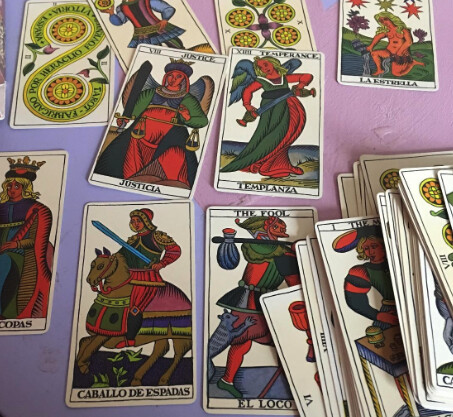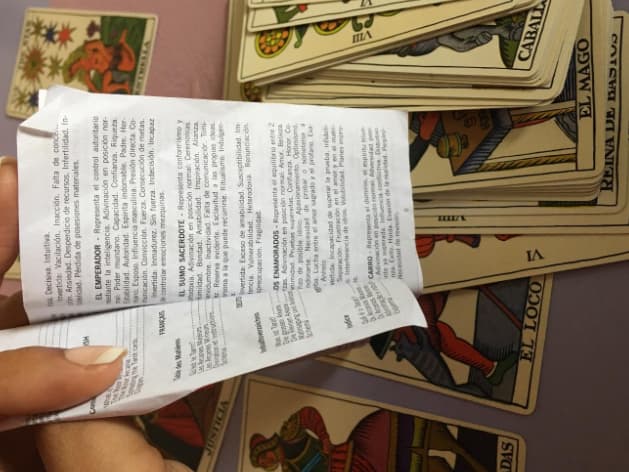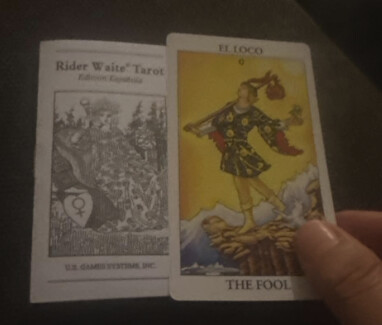I’ve been looking into Spanish tarot cards lately and noticed something interesting. The Spanish deck (baraja española) and tarot share the same four suits - cups, coins, swords, and clubs/wands. From what I’ve read, both types of cards might have come from Mamluk playing cards that showed up in Europe in the 14th century.
The Spanish deck is different though. It only has 40-48 cards compared to tarot’s 78, and no Major Arcana. The court cards are different too - Spanish decks have sota (page), caballo (knight), and rey (king), but no queen. I’ve heard some people do readings with Spanish decks. Has anyone here tried this? I’m curious about the historical connection between these decks and whether Spanish cards work well for divination.
Also looking for recommendations if anyone knows good Spanish deck brands or versions to try out.
19 Likes
Deepen Your Tarot Practice Beyond the Cards
Finding meaningful tarot discussions and authentic guidance can be surprisingly difficult. Discover a space where your questions are welcomed and your intuitive growth is celebrated: Start Your Journey
This is the main one from my collection. The Booklet isn’t much so if it was my first deck I wouldn’t be trying to learn from it but the cards are good quality.
And if you want something more… standard there’s this one. They’re not the best quality cards I’ve ever had, but they’re the standard RWT in Spanish if that’s what you’re looking for.
Spanish naipes have a cool vibe that works well with moon water charging. The simple designs seem to let the moon’s energy flow through more easily.
Yeah I’ve been doing the same thing - expecting Spanish decks to work like tarot. Doesn’t really work that way though. They’re more straightforward with just the 40 cards. Sometimes I like the simplicity but other times I want more depth and detail that you get with a full tarot deck.
While I was looking through Lo Scarabeo’s collection, my tabby Luna was stretched out on my keyboard.
A velvet pouch is really handy for keeping Spanish decks. The smaller card count fits well and doesn’t have the bulk of a full tarot deck. Their tarot mats provide a nice surface for Spanish deck spreads, too. It adds a mystical feel to the barajas, which seems to catch the attention of my other cat, Midnight, during readings.
I stumbled upon a section on TarotArts dedicated to Spanish tarot and oracle decks. If you’re interested in exploring Spanish-language versions, this might be a good place to start, especially if you like both traditional baraja espaola and tarot.
Ah, the baraja espaola, those traditional Spanish cards? They’re different from Spanish Tarot btw, which is an actual tarot deck. People definitely do readings with them. I see them at parties and family gatherings sometimes.
Like most regional playing cards, they’ve got their own symbolism that doesn’t match up with tarot. I watched someone do readings with them at a wedding reception once. The meanings were way different from tarot cards. If you’re interested, try searching ‘baraja espaola leer’ on YouTube.
There are tons of readers demonstrating different techniques, especially in more casual settings than formal tarot sessions.
I’ve been collecting different divination decks from around the world this year. The numbers feel the same across decks; the three of cups is always about community, whether it’s Spanish baraja or regular tarot. Spanish cards have their own visual language though.
Without the Major Arcana you have to rely more on the imagery and your gut feeling.
A lot of folks overlook the benefits of using tarot decks in various languages.
If you try using Spanish tarot decks, you’ll likely find yourself learning new words and cultural perspectives just by understanding the card meanings and symbols. This exposure to a new language can add a layer to your readings that you won’t get from just translating them.
Been comparing my Spanish Tarot deck with newer ones from Luis Royo and Anne Stokes. It’s cool seeing how far the art has come from the old Marseilles decks. The modern ones have their own style but still stick to the traditional card meanings.
Spanish decks have a different vibe during the equinoxes. Something about the balance themes in the cards lines up with the seasons changing.
You got me looking through my grandmother’s old baraja espaola last night, comparing it to my regular tarot decks. I was trying to figure out if the Knight of Cups would be like a Caballo de Copas.
The Spanish deck thing is interesting, no feminine court figures at all. Makes me wonder about the whole patriarchy aspect of it. Though I guess I’m also bringing my own baggage to it. Like, why am I expecting them to follow the same gender patterns I’m used to?
My therapist keeps telling me to look at things in their own context instead of through my lens. Still working on that one.
Mercury’s going into Sagittarius next week. Been thinking about trying Spanish deck reversals since they work differently than tarot. Thing is, Spanish cartomancers usually skip reversals completely. They focus on card combinations and where cards fall instead. Maybe try laying them in crosses or lines?
The 40-card system doesn’t really fit into standard tarot spreads anyway. Sagittarius fire energy does work well with Spanish interpretations though, they’re more direct and focused on actual actions.
The Spanish decks don’t have a Queen, she’s replaced by the Knight/Caballo, so you get this all-male lineup of Page, Knight, and King.
Maybe something to do with medieval Spain, where knights probably had more real influence than queens did. When I work with these cards, the energy feels different. The Knight has to cover both warrior and caretaker roles, which normally get split between Knight and Queen in regular tarot.
Been working with the Fournier 1736 Liguria-Piedmont reproduction for a while. Love those old woodblock prints. The Spanish naming system is nice, Bastos for wands, Copas for cups, etc.
The printing style from back then gives it this weathered look that I prefer over the glossy new stuff. Just feels more grounded when I use it for readings. Not sure why exactly.
I just wrapped up ‘Naipes y Cartomancia Espaola’ by Marina Senz. She does a good job of diving into the Spanish fortune-telling methods from different parts of the country. I found it thought-provoking that readers in Andalusia use distinct card spreads compared to those in Catalonia. Has anyone else checked this out? It’s got me thinking about how regional practices can vary so much.


